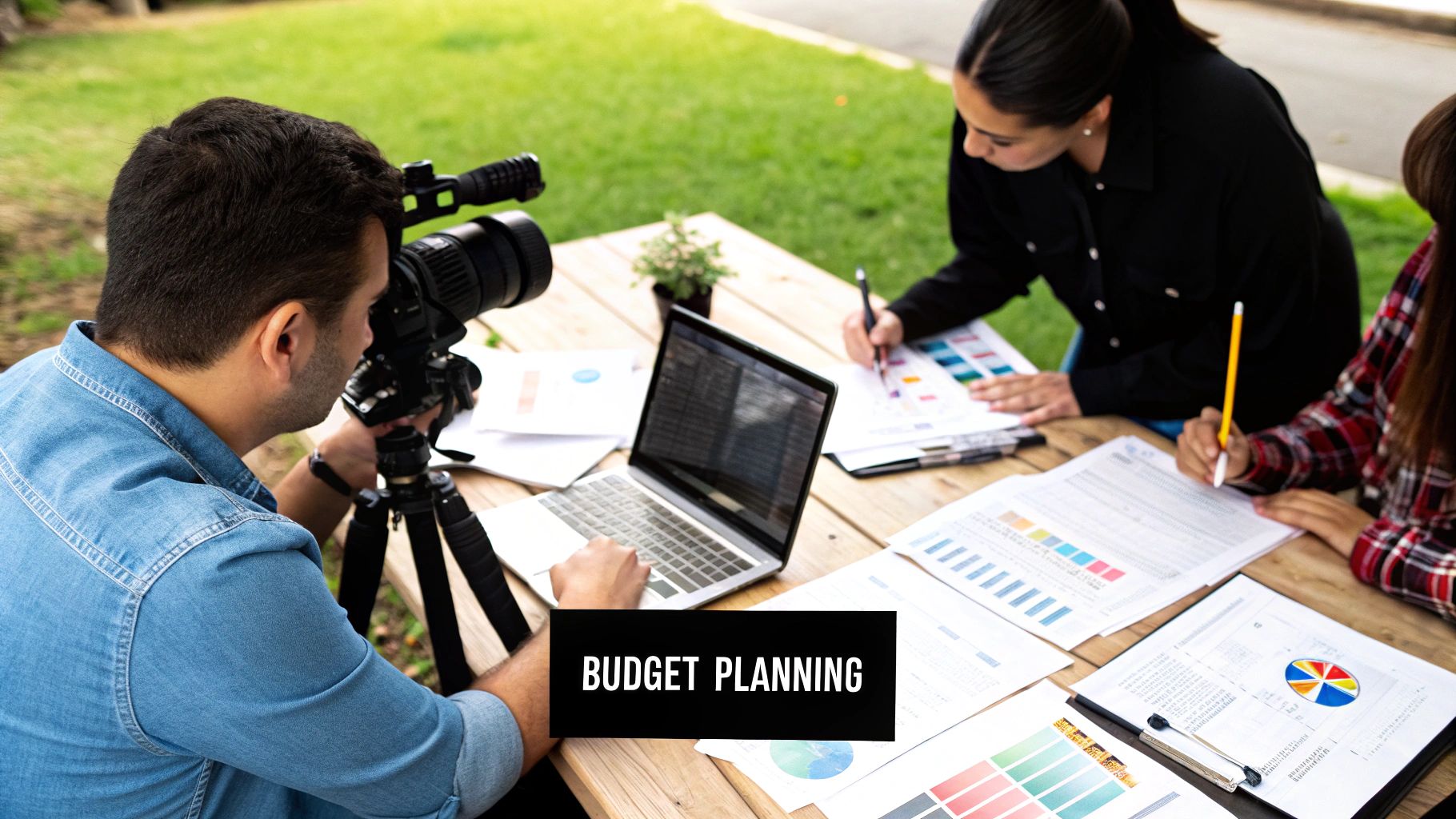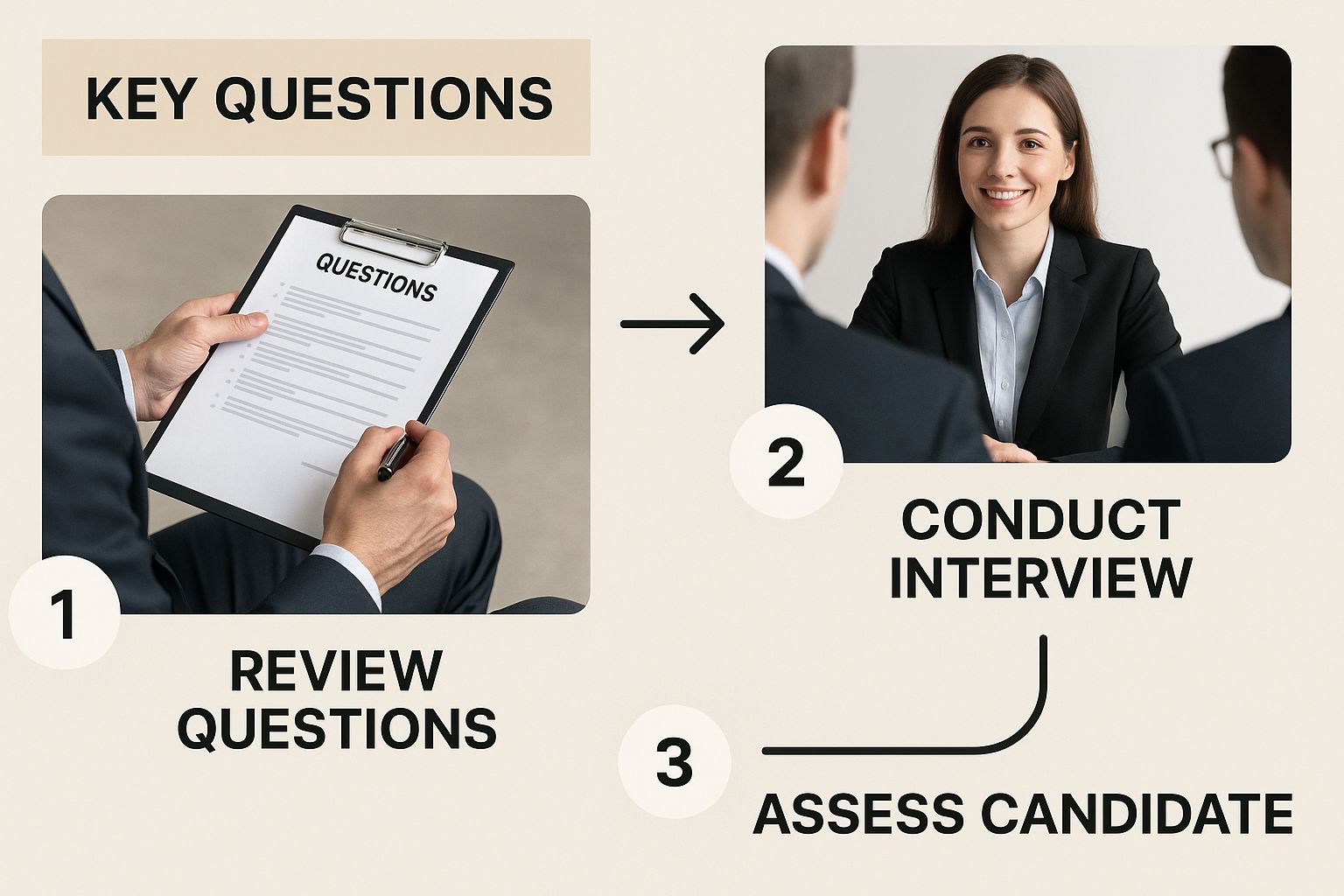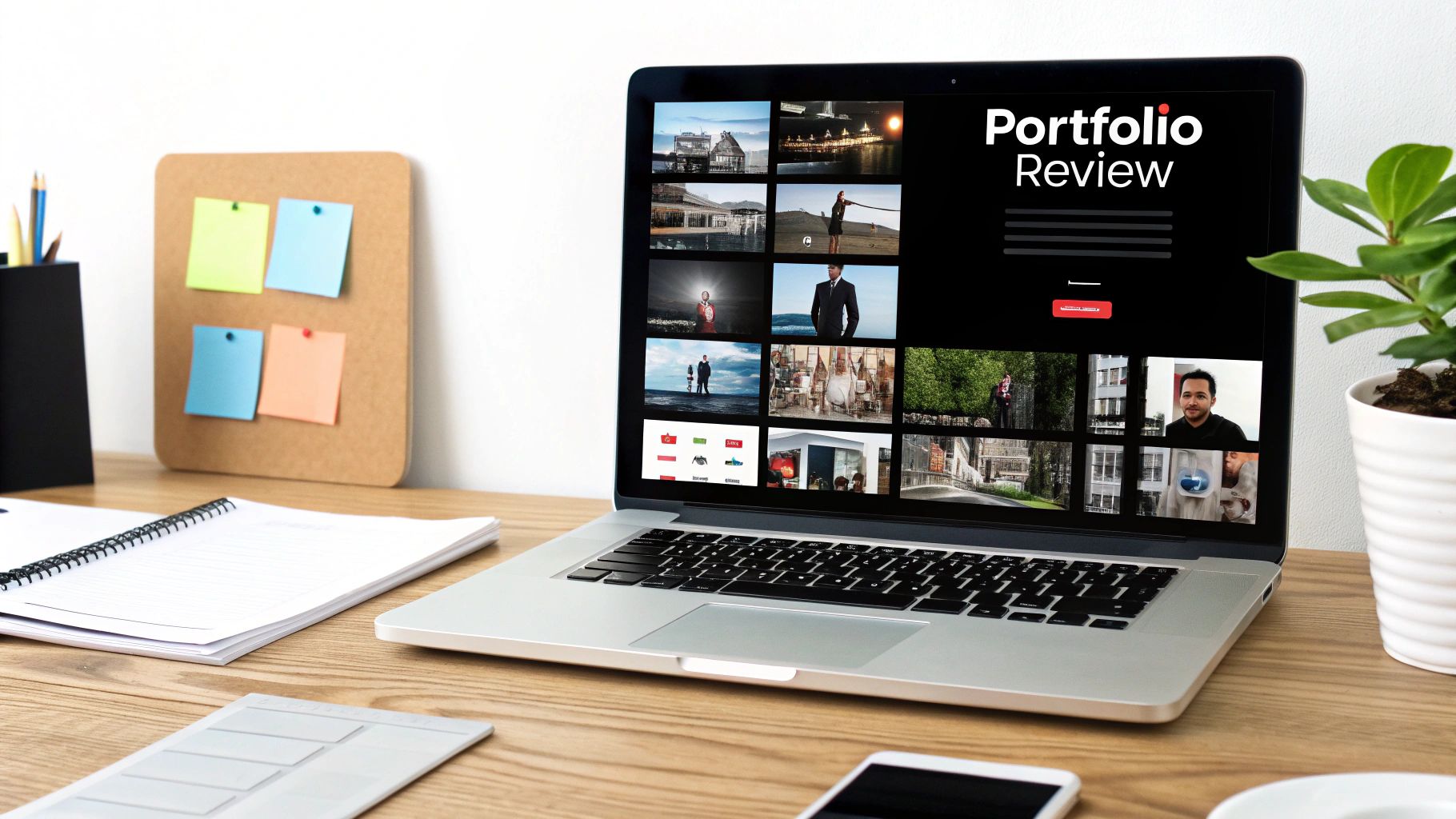Hiring a videographer isn't just another line item on your budget. Think of it as a strategic investment in how your brand tells its story. A pro takes your vision and turns it into a powerful communication tool—something that grabs attention, gets people talking, and makes your brand look a whole lot more polished than any DIY attempt ever could.
Why Hiring a Videographer Is a Smart Investment
Let's skip past the obvious: yes, video is essential. We all know that. The real conversation is about how professional video actually impacts your business.
Picture this: you have a shaky, poorly-lit video from an event. It gets maybe a dozen views before sinking into the digital abyss. Now, imagine a professionally shot piece that weaves a compelling story. One is digital noise; the other is a genuine asset you can use for years.
When you hire the right person, you're not just getting someone with a fancy camera. You’re bringing on a partner who gets lighting, composition, sound design, and how to build a narrative. Those are the skills that turn a simple recording into a cinematic experience that actually connects with people.
The True Value of Professional Quality
A polished video immediately signals that you're professional and credible. It tells potential customers you care about quality, and that perception bleeds over into how they see your products or services.
This isn't just a "nice-to-have" anymore; it's quickly becoming the standard. The global video production market is expected to rocket from $70.40 billion in 2022 to an eye-watering $746.88 billion by 2030. That explosion tells you everything you need to know about the demand for professional-grade content.
A great videographer does more than just press record. They find the story, capture the emotion, and package it in a way that moves people to action. It's the difference between showing what you do and showing why it matters.
Beyond the Camera: An Expert Partner
A pro also brings a level of efficiency and expertise that will save you a ton of time and stress. They handle the whole circus, from pre-production planning all the way through post-production editing, making sure the entire process is seamless.
While you might be tempted to cut corners on certain things—like using AI for a voiceover instead of hiring a voice actor—those tools rarely match the quality and nuance an actual expert provides. At the end of the day, investing in a professional videographer is an investment in your brand's future.
Laying the Groundwork Before You Even Search

Hold up. Before you even think about typing "videographer near me" into Google, you need to do one thing first. The most crucial part of hiring a videographer happens long before you see a single portfolio.
You have to get crystal clear on your project's vision.
Without that roadmap, you’re just wandering. A solid project brief is your compass, making sure every creative you talk to gets it from the very first conversation. Trust me, spending a little time on this now saves a ton of headaches later and helps you find people who are actually the right fit for your project.
Nailing Down Your Creative Brief
Think of your brief as the answers to a few core questions. It doesn't have to be some fancy, formal document—just a straightforward guide to get everyone on the same page.
Start by jotting down the basics:
- The Main Goal: What’s the one thing this video absolutely must do? Is it about raking in new leads? Boosting your brand on social? Or maybe it's for training new team members?
- Your Audience: Who are you trying to talk to? And be specific. "Millennials" is way too broad. Something like "tech-savvy entrepreneurs aged 25-35" is so much better.
- The Key Message: If someone only remembers one thing from this video, what should it be?
- Tone & Style: What's the vibe? Are we going for a heartfelt, cinematic documentary feel, or is it more of an energetic, fast-paced, punchy kind of thing?
A clear brief isn't about boxing in creativity. It's about giving it the right playground to thrive in. When a videographer knows the 'what' and the 'why,' they can pour all their expertise into figuring out the 'how'.
Let's make this real. A brief for a corporate testimonial video is going to be all about authenticity, professionalism, and building trust. The audience is other potential B2B clients, and the core message is that you're reliable.
On the flip side, a brief for a social media ad would focus on high energy, quick cuts, and a can't-miss call-to-action to grab a younger audience's attention. Getting this distinction down on paper from the get-go means you’ll attract videographers who already have the right style in their back pocket, making the whole hiring process a lot smoother.
Got your creative brief locked and loaded? Awesome. Now for the fun part: finding the right person to bring it to life.
You can always start with a simple search, but the real gems are usually found a little deeper. Professional hubs like LinkedIn are great for tracking down established corporate videographers. If you're after someone with a more artistic or cinematic flair, creative communities like Vimeo and Behance are where you'll want to spend your time.
Don't forget to tap your own network. A good old-fashioned referral is gold. Ask other business owners you trust or check in with your marketing team. When someone comes highly recommended, it means they’ve already passed the vibe check for professionalism and quality, which can save you a ton of time. You can also dive into talent pools on freelance platforms like Fiverr to see a wide range of options at different price points.
So, How Do You Evaluate Their Work?
A portfolio is way more than just a highlight reel. It’s where you can see a videographer's skills, style, and storytelling chops in action. Here’s what I look for when I’m digging through someone’s work:
- The Technical Stuff: First, let's talk fundamentals. Is the lighting clean and consistent? Is the audio crisp, or can you hear wind and background chatter? Shaky camera work and muddy sound are instant deal-breakers for me.
- The Storytelling: A great video makes you feel something. It’s not just a collection of pretty shots. Does the video have a clear flow—a beginning, middle, and end? Does the editing pace match the mood? You're looking for someone who can craft a narrative, not just point and shoot.
- A Consistent Vibe: Does their portfolio have a recognizable style? It’s totally fine if they’ve worked on different types of projects, but there should be a creative signature that ties it all together. If their work is all over the place, it might mean they haven't quite found their unique voice yet.
While a diverse portfolio is a plus, be wary of someone who only has one type of video. If you need a corporate interview video, the person who only shoots music videos might not be the right fit. It's a similar process for other creatives, too—we've got another guide on what to look for when you hire graphic designers that has some handy overlapping tips.
This is the point where I build a quick checklist to keep my thoughts organized before I even think about hopping on a call.
Videographer Vetting Checklist
Use this quick checklist to systematically review a candidate's portfolio and initial communications. It helps you stay objective and compare everyone using the same criteria.
| Vetting Criteria | What to Look For | Red Flags |
|---|---|---|
| Portfolio Quality | High-resolution footage, clear audio, and professional editing. | Shaky video, poor sound, inconsistent color grading. |
| Relevant Experience | Projects similar to yours in scope, style, or industry. | Portfolio contains only personal projects or a totally different niche. |
| Storytelling | Videos have a clear narrative, emotional impact, and logical flow. | A collection of random shots with no clear purpose. |
| Professionalism | A well-organized website/portfolio, clear communication. | Unresponsive to emails, typos, a messy or broken portfolio site. |
Once you've done this initial review, you'll have a solid shortlist and be ready to start conversations.
The image below gives you a great starting point for the kinds of questions you should be ready to ask once you move on to the interview stage.

Having these questions prepped helps turn a casual chat into a productive conversation, making sure you cover all your bases.
Don't skip this vetting step. The right videographer is a huge asset, especially when you consider that video is projected to make up 82% of all internet traffic by 2025. On top of that, video ad spending in the U.S. is expected to reach a staggering $130.97 billion. Finding a true pro is more important than ever.
Getting a Feel for Your Candidates and Their Proposals

Alright, you’ve got your shortlist of talented videographers. Now it's time to move past their polished portfolios and have a real conversation. This is where you find out if they’re just a technician or a true creative partner.
Forget asking what camera they use. Seriously. Instead, you want to dig into how they think, solve problems, and communicate. That’s what really matters when the pressure is on and things don’t go perfectly to plan.
Asking the Right Questions
Your goal here is to get a sense of their personality and process. I’ve found the best way to do this is with open-ended, scenario-based questions that let them tell you a story.
Here are a few of my go-to questions to get the ball rolling:
- "Walk me through a project where you had a crazy tight deadline or something totally unexpected happened. How did you handle it?"
- "How do you like to work with clients during the editing phase? What does your feedback process look like?"
- "Looking at our project brief, what's the one thing that gets you most excited from a creative standpoint?"
These kinds of questions shift the conversation from gear to grit. You learn how they think on their feet, how they collaborate, and if they'll be a good fit for your team. This is a crucial part of hiring a videographer who will feel like an extension of your brand.
The best interviews feel less like an interrogation and more like a creative brainstorming session. You’re not just hiring someone to push a button; you’re starting a collaboration.
Decoding the Proposal
After the chats, the proposals will start rolling in. This document is so much more than a price tag—it's the blueprint for your entire project. You need to look at it with a magnifying glass.
A solid proposal should spell everything out, leaving no room for surprises. Make sure it clearly defines:
- Deliverables: What are you actually getting? One 3-minute video? Two 30-second social cuts? Get specific.
- Revision Rounds: How many rounds of edits are included? Knowing this upfront is a lifesaver.
- Timeline: A clear schedule from the shoot day to the final delivery date. No vague promises.
- Itemized Costs: A full breakdown of filming, editing, music licensing, and any other potential fees.
And if your project involves aerial shots, it's worth getting a handle on how videographers price drone jobs to better understand that part of the quote. Scrutinize every single line item. Are there hidden fees for travel? Do you have to pay extra for the raw footage? Getting clarity now means you can make a confident decision and avoid headaches down the road.
Finalizing the Hire and Nailing Down the Contract
You’ve found them. The perfect creative who totally gets your vision. You're ready to make it official and get the cameras rolling.
But hold on for just a second. Before you pop the champagne, there's one last crucial step: the contract. Think of it less as a stuffy legal document and more as your project's single most important safety net. It protects you, it protects them, and it saves a world of headaches down the line.
Don't let the legal jargon intimidate you. A good contract is all about setting crystal-clear expectations from day one. It’s what prevents miscommunication and that dreaded "scope creep" from derailing your project.
The Make-or-Break Clauses to Look For
Your contract is the detailed roadmap for your entire collaboration. A solid agreement should leave no room for assumptions and spell everything out in plain English.
Here are the non-negotiables you need to pay close attention to:
- Project Scope & Deliverables: Get incredibly specific here. This isn't just about "a brand video." It should detail exactly what you're getting, like "one 3-minute brand video in 4K resolution" and "two 15-second vertical social media clips." The more detail, the better.
- Revision Rounds: This is a big one. How many chances do you get to ask for changes? Most videographers include one or two rounds of revisions in their standard fee. If you think you'll need more, negotiate it upfront, as extra rounds almost always mean extra cost.
- Footage Ownership: Who owns what? Typically, you own the final, polished videos. The videographer, however, usually retains the rights to all the raw, unedited footage. If having those raw files is important to you, you'll need to specify that in the contract, and it will likely come with an additional fee.
- Payment Schedule: This breaks down who pays what, and when. A super common structure is a 50% deposit to lock in your project dates and get the ball rolling, with the final 50% due upon delivery of the final masterpiece.
Your contract is the single source of truth for the entire project. It should wipe out any ambiguity and make sure everyone is 100% aligned on the goals, timeline, and deliverables before a single frame is shot.
The emphasis on professional video isn't just a hunch; the numbers back it up. A whopping 85% of businesses now use video as a core marketing tool, which means the demand for top-tier creators is skyrocketing. On the tech side, the number of people paying for video editing software is projected to blow past 48.22 million by 2025.
If you’re looking for more tips on freelancer contracts, our guide on hiring a freelance graphic designer has some great insights that apply here, too.
Let's Clear Up Some Common Questions
Whenever you're about to hire a videographer, a few questions always seem to pop up. Getting these sorted out early on saves you headaches later and makes the whole process feel a lot less mysterious. Let's walk through some of the big ones.
The first thing on everyone's mind? Cost. There’s no single answer here, as prices can swing wildly depending on the videographer’s experience, where you are, and just how big your project is. A simple, half-day shoot with one person behind the camera might just be a few hundred dollars. But a multi-day corporate gig with a full crew and gear? That can easily get into the tens of thousands.
Who Actually Owns the Raw Footage?
This is a big one, and it’s something that absolutely has to be crystal clear in your contract.
Nine times out of ten, you (the client) own the final, edited video. That's the main thing you’re paying for. But the videographer almost always keeps the rights to all the raw, unedited footage they shot.
If you think you'll need those raw files for other marketing materials or just for your archives, you have to bring this up from the get-go. Expect to pay an extra fee for it—you're basically buying a whole separate asset.
Always work under the assumption that the raw footage is not included unless your contract says it is, plain and simple. Nailing this down before anyone signs anything is the best way to avoid a classic "I thought that was included" moment.
Wait, What’s a Cinematographer?
You might hear "cinematographer" thrown around and wonder if it's the same thing. It's not, and the difference matters.
A videographer is usually a one-person-band. They handle the shooting, the audio, the lighting, and often the editing. They're perfect for events, interviews, social media content, or smaller corporate jobs.
A cinematographer, on the other hand, is part of a much larger crew on a bigger production, like a TV commercial or a film. Their entire world is the art and science of the camera and lighting department. They are hyper-focused on crafting the visual mood and style. For most business projects, what you really need is a videographer.
Sometimes, even with the best intentions, creative collaborations can get a little bumpy. If you ever find yourself in a tight spot, reading up on how to deal with demanding clients can give you some surprisingly useful perspective from the other side of the table.
Finding the right creative to tell your story is everything. At Creativize, we help you connect with talented local professionals who can take your vision and make it real. Explore portfolios and find your perfect match today.

